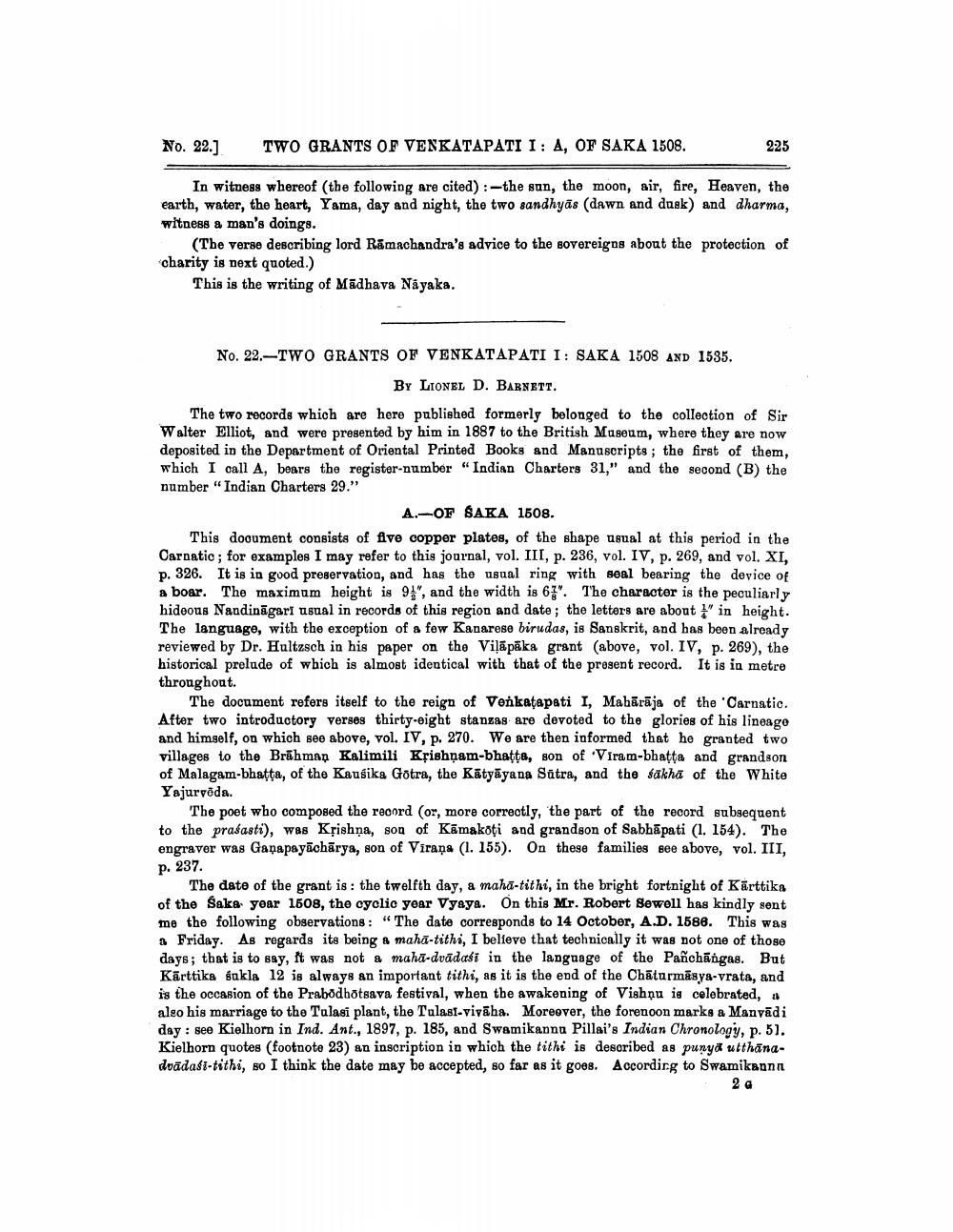________________
No. 22.]
TWO GRANTS OF VENKATAPATI I: A, OF SAKA 1508.
225
In witness whereof (the following are cited) :-the sun, the moon, air, fire, Heaven, the earth, water, the heart, Yama, day and night, the two sandhyās (dawn and dusk) and dharma, witness a man's doings.
(The verse describing lord Ramachandra's advice to the sovereigns about the protection of charity is next quoted.)
This is the writing of Mādhava Nayaka.
No. 22.-TWO GRANTS OF VENKATAPATI I: SAKA 1508 AND 1535.
BY LIONEL D. BABNETT. The two records which are here published formerly belonged to the collection of Sir Walter Elliot, and were presented by him in 1887 to the British Museum, where they are now deposited in the Department of Oriental Printed Books and Manuscripts; the first of them, which I call A, bears the register-number "Indian Charters 31," and the second (B) the number "Indian Charters 29."
A.-OF SAKA 1508. This dooument consists of five copper plates, of the shape usual at this period in the Carnatic; for examples I may refer to this journal, vol. III, p. 236, vol. IV, p. 269, and vol. XI, p. 326. It is in good preservation, and has the usual ring with seal bearing the device of a boar. The maximum height is 94", and the width is 63". The character is the peculiarly hideous Nandināgari usual in records of this region and date; the letters are about " in height. The language, with the exception of a few Kanarese birudas, is Sanskrit, and has been already reviewed by Dr. Hultzsch in his paper on the Viļāpāka grant (above, vol. IV, p. 269), the historical prelude of which is almost identical with that of the present record. It is in metre throughout.
The document refers itself to the reign of Venkatapati I, Mahārāja of the 'Carnatic. After two introductory verses thirty-eight stanzas are devoted to the glories of his lineage and himself, on which see above, vol. IV, p. 270. We are then informed that he granted two villages to the Brāhman Kalimili Krishņam-bhatta, son of Viram-bhatta and grandson of Malagam-bhatta, of the Kausika Gotra, the Kātyāyana Sätra, and the sakhā of the White Yajurpēda.
The poet who composed the record (or, more correctly, the part of the record subsequent to the prasasti), was Kộishna, son of Kāmakoti and grandson of Sabhāpati (1. 154). The engraver was Ganapayāchārya, son of Virana (1. 155). On these families see above, vol. III, p. 237.
The date of the grant is: the twelfth day, a maha-tithi, in the bright fortnight of Karttika of the Sake year 1508, the cyclic year Vyaya. On this Mr. Robert Sewell has kindly sent me the following observations: “The date corresponds to 14 October, A.D. 1586. This was & Friday. As regards its being & maha-tithi, I believe that technically it was not one of those days; that is to say, it was not a maha-dvādasi in the language of the Panchāngas. But Kārttika gakla 12 is always an important tithi, as it is the end of the Chāturmāsya-vrata, and is the occasion of the Prabodhotsava festival, when the awakening of Vishnu is celebrated, also his marriage to the Tulasi plant, the Tulasi-vivāha. Moreover, the forenoon marks a Manrādi day: see Kielhorn in Ind. Ant., 1897, p. 185, and Swamikannu Pillai's Indian Chronology, p. 5). Kielhorn quotes (footnote 23) an inscription in which the tithi is described as punya utthānaduādasi-tithi, 50 I think the date may be accepted, so far as it goes. Accordirg to Swamikann




